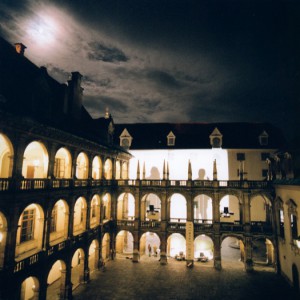
Mexican-Canadian artist Rafael Lozano-Hemmer, has created exceptional urban installations that have helped transform the ways in which we interact with our cities. He uses new media technologies to work with ideas of architecture, technological theater and performance. In 1994, Lozano Hemmer coined the term “relational architecture” as an aim to transform the dominant narratives of urban settings and re-contextualize them.
In his introduction to The City as Interface, 2014, Martijn de Waal introduces the collective term “urban media”, a term used in his book for “media technologies that in one way or another can influence the experience of a physical location.” (p. 8) Media technologies have been, in fact, influencing one’s experience with physical locations and especially cities as seen through Lozano-Hemmer’s work. De Waal raises important questions in his introduction, when exploring the idea of making cities smarter and more efficient through urban media: “Will city dwellers still enter into relationships with their physical surroundings? Will they still participate in community life or will they withdraw completely into the ‘cocoons’ they create with their mobile phones, thereby transforming the city into an extension of their private domains?” (p. 9) The fear of city dwellers roaming the city through the sole presence of their bodies is very prominent for architects, artists, and other dwellers concerned with the community spirit that is inherent to any city. And this is where artists like Lozano-Hemmer step in; to reconnect these city dwellers to their cities through the very use of urban media, therefore reshaping the city and one’s relationship to it, by using new media technologies as urban and ideological tools. In The City as Interface, de Waal explores the possibilities of our cities as interfaces; he explores how urban media can further the ‘libertarian’ urban society, but studies how new media can also help create a new definition of the public sphere and transform it to develop a ‘republican’ urban society into a ‘community of strangers’, but a community nevertheless. De Waal asks the question: “How does the rise of urban media change the way in which public spaces can emerge?” (p. 24) and Hemmer brings an artistic yet socially and ideologically charged solution to it. By posing the important question of agency, in the sense of who has the power and opportunity to influence the way in which the city as an interface is shaped, artists who create urban installations contribute to this ongoing quest in a meaningful and crucial way.
Rafael Lozano-Hemmer comes from a scientific background, which is extremely important knowledge when studying his installations. His scientific background has, in many ways, influenced his work and venture as an artist. His works are very interactive and heavily rely on the audience’s participation, and therefore create a shared public experience among strangers, contributing in many ways to de Waal’s analysis of the republican society.
“Re: Positioning Fear”, 1997, Lozano Hemmer’s third Relational Architecture piece, is a large scale installation on the court yard facade of one of Europe’s largest military arsenals, Landeszeughaus, in Austria.
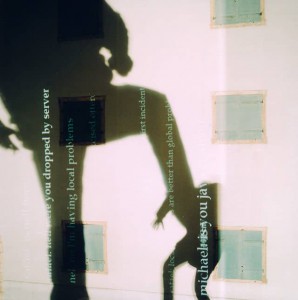
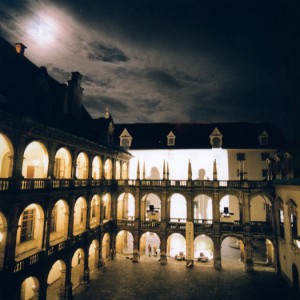
The installation is an interface projecting shadows of city dwellers, finding themselves in front of this fortress. The shadows of the dwellers were automatically focused, and generated sounds through the use of a tracking system. The shadows projected onto the military interface were accompanied by a real-time IRC (Internet Relay Chat) discussion about the transformation of the concept of “fear”, as the title implies, between thirty artists and theorists from seventeen countries around the world. The interface, called “Teleabsence” only allowed the text conversation to appear where the physical participants placed their bodies in front of the facade. The participants had to use their bodies to read the text, making it a highly interactive piece, both through the physical presence of the audience, and the virtual presence of the Internet contributors. A numerical count also followed the shadows wherever they went, calculating their distance to the facade, confronting the participants with the eery and fearful reality of surveillance technology. The sound accompanying the installation also fortified this contemplation on fear and made the experience all the more sensory. The title of the installation also deserves attention in studying this piece. Lozano-Hemmer along with all the artists and theorists involved literally made the participants reposition fear; both bodily and intellectually. Through this installation, fear is explored as both a collective and personal concept, projected onto a historical military landmark to invite the participants to consider and question it within that historical realm, but also outside of it, through the IRC discussion.
“Under Scan”, 2005, Lozano-Hemmer’s eleventh Relational Architecture piece, is an interactive video art installation created for public space, in which city dwellers within that space are detected by a computerized tracking system, which simulates video-portraits projected within the dweller’s shadow.

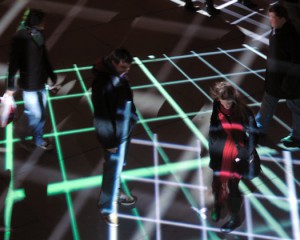

This installation is truly amazing in that it speaks to the concept of surveillance that is increasingly inherent to our cities today, while also serving as a live performance art piece. As the dwellers walk away from their shadows, the video-portrait looks away and eventually disappears if no one activates it, establishing a sense of ephemerality and anonymity, which reflects on the concept of the city being a public sphere and terrain for complete strangers that are nonetheless linked by their shared spaces. Over one thousand portraits of volunteers were taken, and in the presentation of the installation in Trafalgar Square in 2008 the portraits appeared at random locations activated by the dwellers’ shadows. Every seven minutes the piece stopped and reset, to reveal the computerized surveillance tracking system during a brief intermission lighting sequence. This is extremely important to the piece, as it directly confronts the audience with the reality of surveillance and tracking technologies.
Lozano-Hemmer’s sixteenth Relational Architecture installation, “Solar Equation”, 2010, is a large scale public art installation featuring an animated three-dimensional maquette of the Sun, visible at night. This installation premiered at the “Light in Winter” Festival Federation Square, in Melbourne Australia from June 4 to July 4 2010.
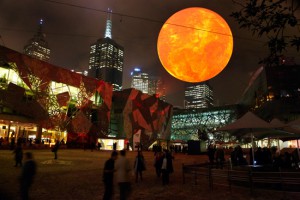

“Solar Equation” consists of an authentic simulation of the Sun, only 100 million times smaller than our actual Sun. Lozano-Hemmer created the word’s largest captive balloon and animated it using five projectors. The solar animation of the balloon is generated by live mathematical equations, simulating the visual surface of the Sun, which emphasizes the importance of Lozano-Hemmer’s scientific background. These equations produce a display that never repeats itself and that give the viewer an opportunity to catch a glimpse of the beauty of our most beloved planet, the Sun, otherwise only observable at the solar surface. The installation uses the latest SOHO and SDO solar observatory imaging available from NASA, overlaid with live animations derived from various equations. While viewing the installation, viewers have the ability to interact with it in real-time by using an iPhone or other device which disturbs the animations. This installation creates a highly interactive experience.
This piece is extremely powerful in the largeness of its scope. It invites the audience to experience the Sun in a variety of manners: to experience its romantic quality inherent to its ephemerality, to perhaps contemplate the urgent question of global warming, but also to create their own personal narrative around the piece. Its scale and beauty engage the viewer to interact with the piece, yet its design assures the minimum urban disturbance. The balloon being tethered 20 meters above the ground, the audience is able to roam freely under it, during night and day, making it extremely subtle yet so powerful. Its power is expressed through this very subtleness: city dwellers can decide weather to be impacted by the work, which mirrors the very nature of the Sun; everyone is aware of its presence, yet its distance prohibits it from being forced upon us. The piece is also accompanied by sound; a live channel or rumbles, crackles and bursts, that is a live software simulation of solar activity, heard only faintly under the maquette. By bringing an audience together under this installation, Hemmer seems to make a metaphor about the very nature of the Sun in relation to society; we are collectively constantly standing under it, no matter where we are in the world, and it connects us without having to interact directly. This places his installation at the intersection of architecture and performance art and through this work, Lozano-Hemmer embraces urban media technologies to create platforms for public participation.


